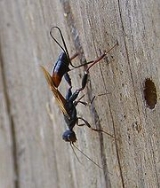
Stephanidae
Encyclopedia
Stephanoidea is a small Hymenoptera
n superfamily that includes a single extant family, Stephanidae with 9 genera and almost 300 species, primarily tropical and subtropical in distribution. They all have a slender and oddly elongated body, highly modified hind legs, and a somewhat spherical head on a long "neck", bearing a set of about five "teeth" on the face surrounding the ocelli
. They thus somewhat resemble Gasteruptiidae
, but they are glossy and often sculptured, and the swollen hind femora
are unlike any gasteruptiid leg.
There are reports that these wasps are parasitoid
s of xylophagous
beetle
larva
e, though the one species whose biology is well-known (Schlettererius cinctipes) is a parasitoid of horntail
wasps.
Hymenoptera
Hymenoptera is one of the largest orders of insects, comprising the sawflies, wasps, bees and ants. There are over 130,000 recognized species, with many more remaining to be described. The name refers to the heavy wings of the insects, and is derived from the Ancient Greek ὑμήν : membrane and...
n superfamily that includes a single extant family, Stephanidae with 9 genera and almost 300 species, primarily tropical and subtropical in distribution. They all have a slender and oddly elongated body, highly modified hind legs, and a somewhat spherical head on a long "neck", bearing a set of about five "teeth" on the face surrounding the ocelli
Ocellus
A simple eye refers to a type of eye design or optical arrangement that contains a single lens which detect light. A "simple eye" is so-called in distinction from a multi-lensed "compound eye", and is not necessarily at all simple in the usual sense of the word...
. They thus somewhat resemble Gasteruptiidae
Gasteruptiidae
The family Gasteruptiidae is one of the more distinctive among the Apocritan wasps, with surprisingly little variation in appearance for a group that contains around 500 species in 9 genera worldwide. The propleura form an elongated "neck", the petiole attaches very high on the propodeum, and the...
, but they are glossy and often sculptured, and the swollen hind femora
Arthropod leg
The arthropod leg is a form of jointed appendage of arthropods, usually used for walking. Many of the terms used for arthropod leg segments are of Latin origin, and may be confused with terms for bones: coxa , trochanter , femur, tibia, tarsus, ischium, metatarsus, carpus, dactylus ,...
are unlike any gasteruptiid leg.
There are reports that these wasps are parasitoid
Parasitoid
A parasitoid is an organism that spends a significant portion of its life history attached to or within a single host organism in a relationship that is in essence parasitic; unlike a true parasite, however, it ultimately sterilises or kills, and sometimes consumes, the host...
s of xylophagous
Xylophagy
Xylophagy is a term used in ecology to describe the habits of an herbivorous animal whose diet consists primarily of wood. The word derives from Greek ξυλοφάγος "eating wood", from ξύλον "wood" and φαγεῖν "to eat", an ancient Greek name for a kind of a worm-eating bird...
beetle
Beetle
Coleoptera is an order of insects commonly called beetles. The word "coleoptera" is from the Greek , koleos, "sheath"; and , pteron, "wing", thus "sheathed wing". Coleoptera contains more species than any other order, constituting almost 25% of all known life-forms...
larva
Larva
A larva is a distinct juvenile form many animals undergo before metamorphosis into adults. Animals with indirect development such as insects, amphibians, or cnidarians typically have a larval phase of their life cycle...
e, though the one species whose biology is well-known (Schlettererius cinctipes) is a parasitoid of horntail
Horntail
Horntail or wood wasp is the common name for any of the 100 non-social species of the family Siricidae, of the order Hymenoptera, a type of xylophagous sawfly...
wasps.

